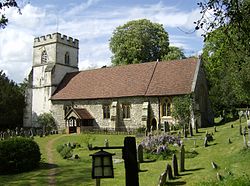Medmenham
| Medmenham | |
| Buckinghamshire | |
|---|---|
 St Peter's parish church | |
| Location | |
| Grid reference: | SU8084 |
| Location: | 51°33’14"N, -0°50’17"W |
| Data | |
| Population: | 1,030 (2011[1]) |
| Post town: | Marlow |
| Postcode: | SL7 |
| Dialling code: | 01491 |
| Local Government | |
| Council: | Buckinghamshire |
| Parliamentary constituency: |
Wycombe |
Medmenham is a village and parish in Buckinghamshire. It is on the River Thames, about 3½ miles south-west of Marlow and three miles east of Henley-on-Thames.
Toponym
The toponym is derived from the Old English for "middle-sized homestead". An alternative explanation of the name is from the Saxon leader Meda, whose followers were known as Medings, hence Medin'ham, Medham, or Medmenham. It was recorded in the Domesday Book of 1086 as Medmeham.
Features
The village includes some old timber-framed brick and flint cottages and some estate workers' cottages built at the beginning of the 20th century from local chalk rock. The Church of England parish church of Saint Peter was heavily restored in 1839. The Dog and Badger Inn on the A4155 road dates from late in the 16th century, the name having been transferred from the inn at Hambleden which was renamed the Stag and Huntsman.
The village lane ends at the Old Ferry crossing which ceased to be used after the Second World War. It was where the Thames towpath crossed from the Buckinghamshire to Berkshire bank of the river. On the towpath beside the former ferry crossing stands the large Medmenham Ferry Memorial that commemorates Lord Devonport's successful 1899 defence of the public right-of-way over the ferry.
Next to the village, but separated from it by the A4155, is the first of two Iron Age hill forts, Medmenham Camp. Danesfield Camp also known as Danes Ditches is located slightly further along the road to the east near to the village of Hurley.[2]
Also attached to the village are the hamlets of Lower Woodend and Rockwell End.
Abbey
A Cistercian abbey was founded in Medmenham in the 12th century under the ownership of Woburn Abbey, though it was not officially recognised by royal charter until 1200. In 1547, at the Dissolution of the Monasteries, the abbey was seized and given to the Moore family and then sold privately to the Duffields. It was while in the possession of the Duffields that the abbey became infamous as the location of The Hellfire Club, formerly called the Monks of Medmenham.
In 1755, when Sir Francis Dashwood acquired the ruins of the ancient abbey from the Duffield family, he and John Montagu, 4th Earl of Sandwich attended a service at St Peter's parish church in Medmenham where Sandwich released a small monkey in the church. The congregation fled in horror, sure that Satan himself had invaded their place of worship.
Today the abbey is a private residence and is not open to the public.
References
- ↑ "Civil Parish population 2011". Neighbourhood Statistics. Office for National Statistics. http://www.neighbourhood.statistics.gov.uk/dissemination/LeadKeyFigures.do?a=7&b=11126443&c=Medmenham&d=16&e=62&g=6404840&i=1001x1003x1032x1004&m=0&r=1&s=1479998968365&enc=1. Retrieved 24 November 2016.
- ↑ Bucks Archaeological Service Later Bronze Age and Iron Age Historic Environment Resource Assessment, retrieved 23 April 2009Template:Dead link
Outside links
| ("Wikimedia Commons" has material about Medmenham) |
- Medmenham information from Wycombe Council
- Medmenham Village Cricket Club
- UK & Ireland Genealogy — Medmenham historical information
- Cistercian Abbeys: Medmenham
- Medmenham, Buckinghamshire
- The Lives & Times of the Hell-Fire Club
- The Medmenham Monks, aka The Hell-Fire Club
- St Peter and St Paul Church, Medmenham
- Medmenham Village Hall Website
